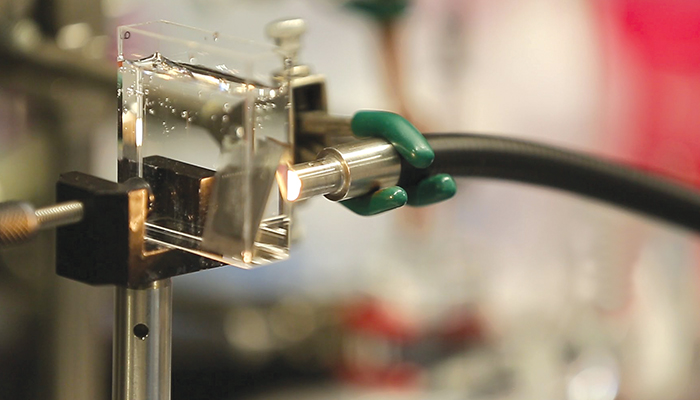All
Bionic Leaf Turns Sunshine, Water and CO2 Into Liquid Fuel
by Ed Burke, Dennis K. Burke Inc.

“Bill Gates has said that to solve our energy problems, someday we need to do what photosynthesis does, and that someday we might be able to do it even more efficiently than plants,” says Daniel Nocera who pioneered the use of artificial photosynthesis. “That someday has arrived.”
Harvard University’s Daniel Nocera, professor of energy science, and his colleague Pamela Silver, professor of biochemistry and systems biology, co-created a system that completes the process of making liquid fuel from sunlight, carbon dioxide and water.
The cross-disciplinary team has created the first “bionic leaf,” which combines H2O-splitting solar energy with hydrogen-eating bacteria to produce liquid fuels. The system uses a pair of catalysts to split water into oxygen and hydrogen, then feeds the hydrogen to bacteria along with carbon dioxide. The bacteria are bioengineered to specific characteristics, converting the carbon dioxide and hydrogen into liquid fuels.
In the first version of the device, which debuted in 2015, the catalyst used to produce hydrogen had a few challenges, notes Nocera. “The nickel-molybdenum-zinc alloy would create reactive oxygen species that attacked and destroyed the bacteria’s DNA. We designed a new cobalt-phosphorous alloy catalyst that does not make reactive oxygen species. That allowed us to lower the voltage, and that led to a dramatic increase in efficiency.”
Dubbed “bionic leaf 2.0,” the new system marks a tenfold improvement on the team’s previous version and could be used to generate liquid fuels, along with many other products. By changing some of the bacteria’s key genes, the bacteria produced alcohol isopropanol, isobutanol and isopentanol. The catalyst’s new chemical composition allows it to “self-heal,” meaning it wouldn’t leach material into the solution. The leaf also scrubs carbon dioxide from the air at a rate of 180 grams per kilowatt-hour.
Bionic leaf 2.0 can convert solar energy to biomass with 10-percent efficiency. That’s much higher than the natural photosynthesis of even the fastest-growing plants, which converts about one percent of solar energy into carbohydrates.
In nature, plants use sunlight to make carbohydrates from carbon dioxide and water. Artificial photosynthesis seeks to use the same inputs — solar energy, water, and carbon dioxide — to produce energy-dense liquid fuels.
The new system can use pure carbon dioxide in gas form, or carbon dioxide captured from the air — which means it has the potential to be “carbon-neutral,” that is, it can create fuel without emitting any additional carbon into the atmosphere.
“The 10 percent number, that’s using pure CO2,” says Nocera. Allowing the bacteria themselves to capture carbon dioxide from the air, he adds, results in efficiency of 3 to 4 percent, still significantly higher than natural photosynthesis.
According to Dick Co, who heads the Solar Fuels Institute at Northwestern University, the innovation of the new system lies not only in its superior performance, but also in its fusing of two usually separate fields: inorganic chemistry (to split water) and biology (to convert hydrogen and carbon dioxide into fuel). “What’s really exciting is the hybrid approach to artificial photosynthesis,” says Co. “It’s exciting to see chemists pairing with biologists to advance the field.”
Looking beyond creating liquid fuels, Silver said, “The beauty of biology is it’s the world’s greatest chemist – biology can do chemistry that we can’t do easily.” She added, “In principle, we have a platform that can make any downstream carbon-based molecule. So, this has the potential to be incredibly versatile.”
“This is a true artificial photosynthesis system,” Nocera said. “Before, people were using artificial photosynthesis for water-splitting, but this is a true A-to-Z system, and we’ve gone well over the efficiency of photosynthesis in nature.”
Commercializing the technology is still a few years out, however. The plan is to roll the fuel version out in developing countries and if it fulfills its potential there, to take it to the rest of the world. In any case, the prospect of turning sunlight into liquid fuel suddenly looks a lot closer.
Related Posts
 National Energy Choice Legislation Advances Through Committee
National Energy Choice Legislation Advances Through Committee
Posted on November 20, 2025
 New and Improved: NEFI Member Benefits Deliver More Value
New and Improved: NEFI Member Benefits Deliver More Value
Posted on October 17, 2025
 It’s Upgrade Season. Get the Sale.
It’s Upgrade Season. Get the Sale.
Posted on October 16, 2025
 The Value of Providing Value
The Value of Providing Value
Posted on October 16, 2025
Enter your email to receive important news and article updates.
